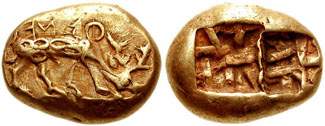Electrum is a naturally occurring amalgam of gold and silver used in the production of coins in Lydia – present-day Turkey – during the 7th century BCE, the first known use of coinage in the West.[1] It was known by the Lydians as green gold, despite being slightly pale lemon in colour, owing to the trace amounts of copper and other elements it contains.[2]
Electrum was more suitable for coinage than gold, being harder and more durable, and techniques for refining gold were not widespread at the time. The gold content of naturally occurring electrum in modern western Anatolia ranges from 70–90 per cent, in contrast to the 45–55 per cent of gold in electrum found in ancient Lydian coinage in the same geographical area. This suggests that the Lydians had learned how to refine silver, and were adding refined silver to the local native electrum some decades before introducing pure silver coins.[3]
Variations in the composition of electrum made it difficult to determine the intrinsic worth of each coin, a hinderance to widespread trading that led to the introduction of coins of pure gold and silver.[4]

